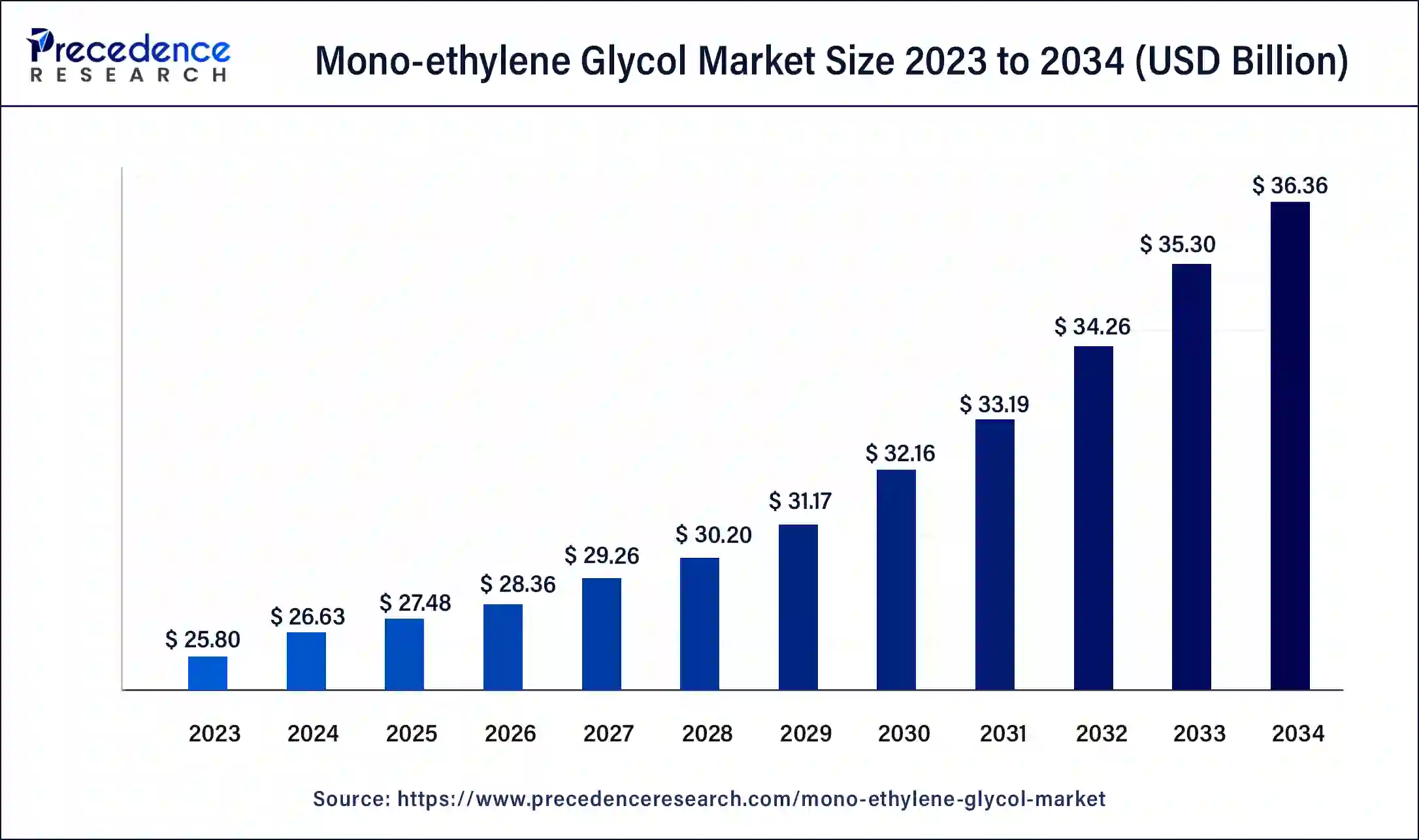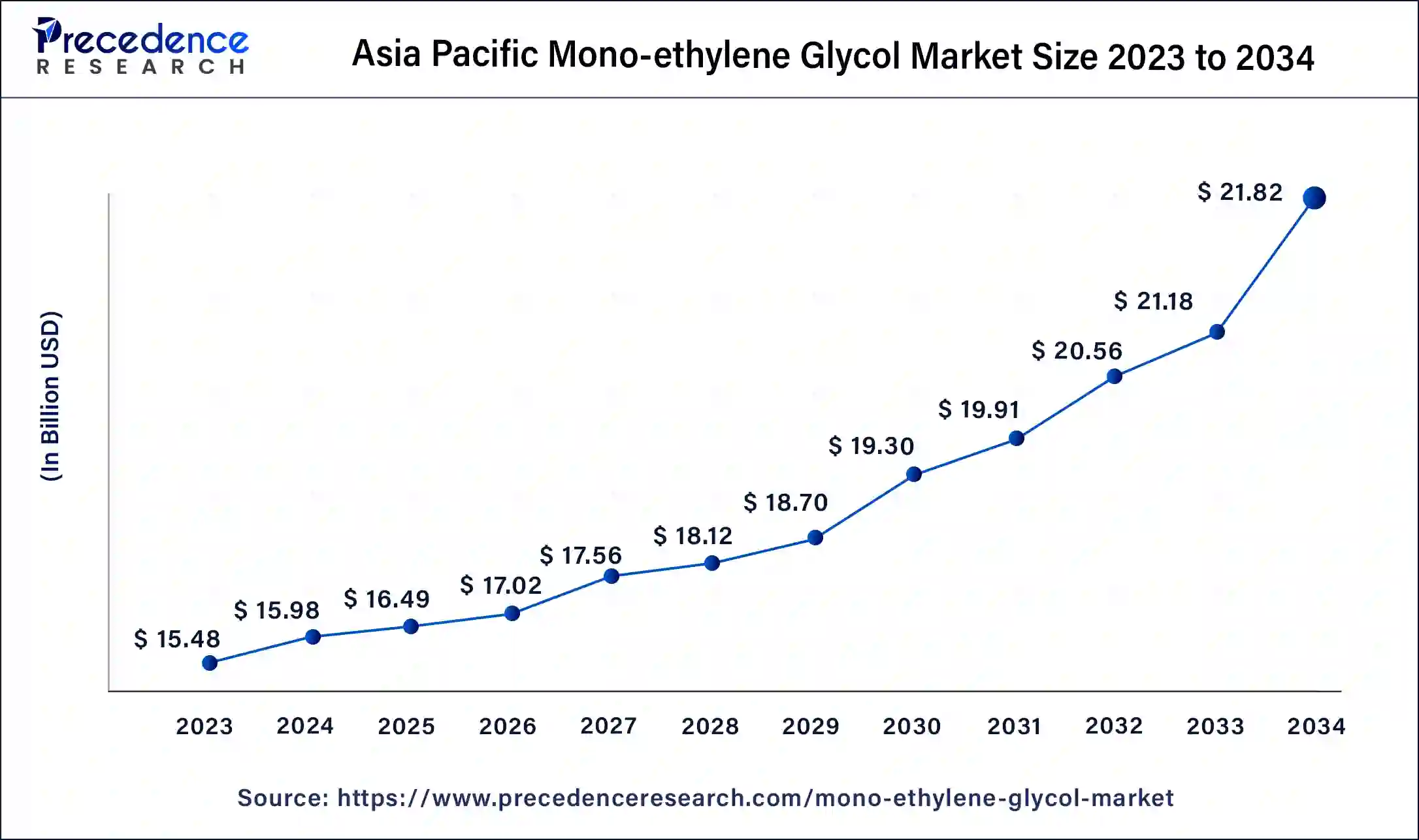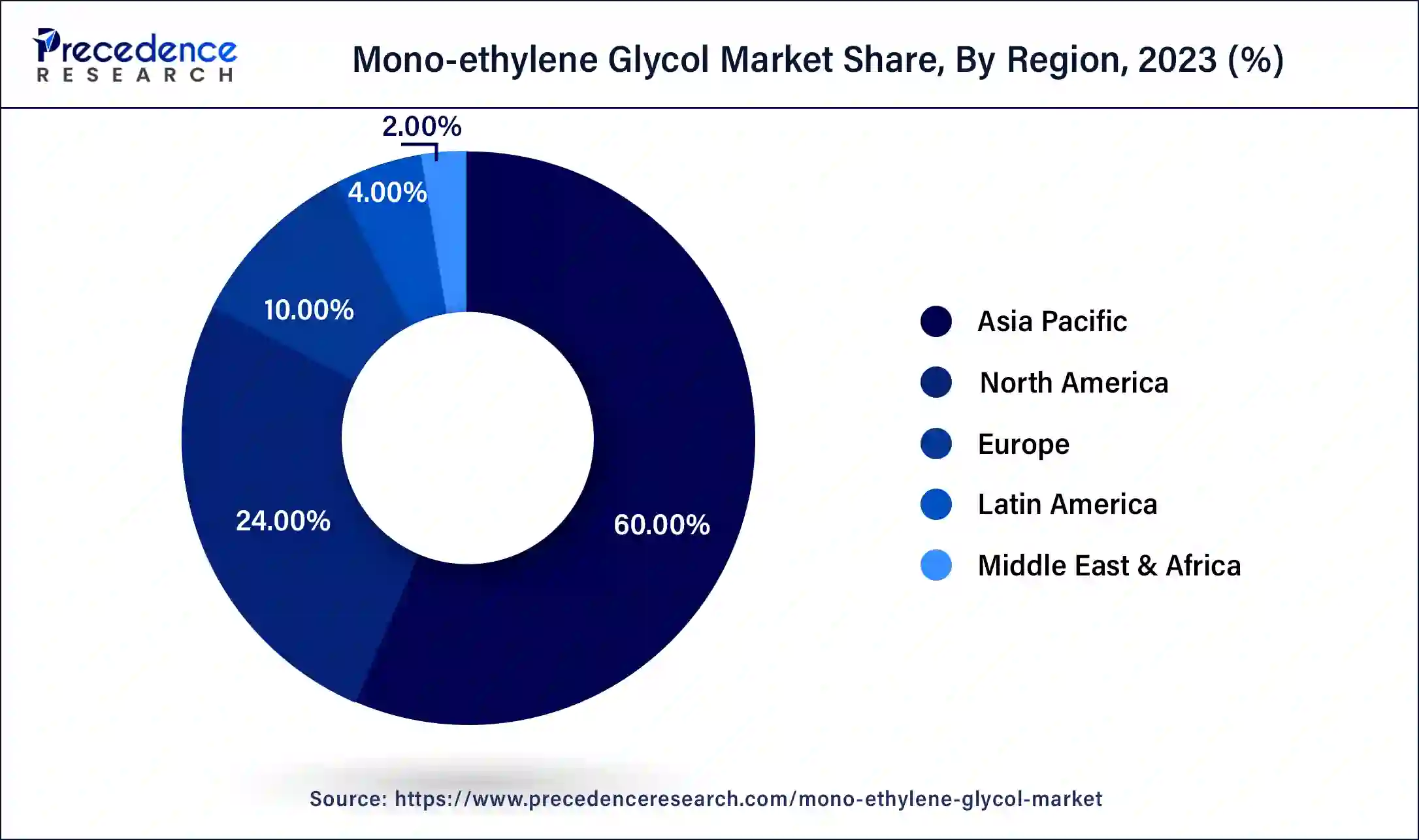List of Contents
What is the Mono-ethylene Glycol Market Size?
The global mono-ethylene glycol market size is calculated at USD 27.48 billion in 2025, and is anticipated to hit around USD 27.48 billion by 2026, and is predicted to reach around USD 37.4 billion by 2035, growing at a CAGR of 3.16% from 2026 to 2035

Market Highlights
- Asia Pacific led the global market with the highest market share in 2025.
- Europe is projected to expand at the fastest CAGR during the forecast period.
- By Grade, the polyester segment registered the maximum market share in 2025.
- By Grade, the industrial segment is expected to expand at the fastest CAGR over the projected period.
- By Application, the polyethylene terephthalate (PET) segment is estimated to hold the highest market share in 2025.
Market Overview
The mono-ethylene glycol is primarily made by oxidizing ethylene in the presence of a silver oxide catalyst at a high temperature. Later, the ethylene oxide is hydrated to yield mono-ethylene glycol as well as di and tri ethylene glycols as by-products. The mono-ethylene glycol is an odorless and transparent liquid. The mono-ethylene glycol can be stored in stainless steel and aluminum as well as trucks and lorries. The polyester fibers, polyethylene terephthalate (PET) resins, and engine coolants all require mono-ethylene glycol as a component.
Due to its vast uses in a variety of end use sectors such as automotive, construction, consumer goods, pharmaceuticals, textile, and chemical processing, the global mono-ethylene glycol market is predicted to rise significantly throughout the forecast period. The rising production of mono-ethylene glycol has resulted from increased demand for polyester fiber from the global manufacturing sectors, which is likely to be a major driver of the mono-ethylene glycol market expansion. The demand for mono-ethylene glycol is expected to rise due to the expanding application of polyethylene terephthalate (PET) in several consumer products such as bottles and containers.
The key market players of the mono-ethylene glycol market are finding new potential in the plastics and polyester industries. The market players should follow strict handling, distribution, and storage guidelines, as mono-ethylene glycol is not regulated for transportation can be dangerous if consumed in liquid form. As a result, the major market players should adopt safety criteria to increase their trust. The mono-ethylene glycol production is being expanded in order to manufacture packaging materials and polyester films.
Market Scope
| Report Coverage | Details |
| Market Size in 2025 | USD 27.48 Billion |
| Market Size in 2026 | USD 28.36 Billion |
| Market Size by 2035 | USD 37.4 Billion |
| Growth Rate from 2026 to 2035 | CAGR of 3.13% |
| Largest Market | Asia Pacific |
| Base Year | 2025 |
| Forecast Period | 2026 to 2035 |
| Segments Covered | Grade, Application, and Region |
| Regions Covered | North America, Europe, Asia-Pacific, Latin America, and Middle East & Africa |
Market Dynamics
Drivers
The rising demand for polyethylene terephthalate (PET) resin, antifreeze, and polyester fibers is a primary factor boosting the mono-ethylene glycol market expansion. The mono-ethylene glycol is also a biodegradable substance, which means it has a lower impact on aquatic life. This element is also assisting in the mono-ethylene glycol market's growth.
On the other hand, the mono-ethylene glycol market's key factors limiting are high crude oil prices and environmental regulations, which have resulted in a smaller number of permitted chemicals on the market. The mono-ethylene glycol is extremely hazardous to humans; ingestion of mono-ethylene glycol can cause serious damage to the heart and kidney. This aspect is also impeding the mono-ethylene glycol market's expansion during the forecast period.
The growth of the mono-ethylene glycol market will be boosted by increased demand for the substance in the manufacturing process of polyester fibers. The polyester fibers are the most widely used fibers in the world, accounting for half of all fiber demand. The industrial fabrics and clothing are just a few of the industries where fibers are used on a large scale. The demand for such fabrics originates from some of the benefits they provide such as resistance to stains, oil, moisture, and water. It resists wear and tear as well. The fiber industry will develop in the next years as a result of these attributes, as will the mono-ethylene glycol market.
The mono-ethylene glycol use is said to be strongly dependent on the economics of the countries around the world. While economies are cyclical, the demand for mono-ethylene glycol for applications such as polyester fibers and polyethylene terephthalate (PET) is expected to continue at strong growth rate. Furthermore, the packaging industry's growth is propelling the mono-ethylene glycol market over the past few years. This has a substantial impact on the mono-ethylene glycol market, which is fueled by urbanization, changing consumer lifestyles, and increased disposable income, among other factors.
The variations in raw materials and the availability of crude oil and other feedstock are one of the notable barriers to the expansion of the mono-ethylene glycol market. Some customers are switching to alternate products that offer better material performance than mono-ethylene glycol because of concerns about its sustainability. Over the projected period, on the other hand, increased acceptance of bio-based mono-ethylene glycol is expected to open up opportunities in the mono-ethylene glycol market. With numerous market players already active in the creation of environmentally friendly products, research and development (R&D) activities are expected to play a vital role in the mono-ethylene glycol market development and growth over the projection period.The mono-ethylene glycol market is likely to benefit from surge in demand for polyethylene terephthalate (PET) containers from a variety of industrial and commercial end use markets including packaging due to their improved resistance strength.
Segment Insights
Grade Insights
In 2025, the polyester segment dominated the mono-ethylene glycol market. Due to its moisture absorption properties, high stability, and a few other characteristics, this grade is mostly used to make polyethylene terephthalate (PET), fiber, and polyester resins. Due to its hygroscopic properties, it is suitable for usage in synthetic rubber, conditioning agents, and other paper products.
The industrial segment, on the other hand, is predicted to develop at the quickest rate in the future years. The industrial grade mono-ethylene glycol is widely used in chemical intermediates, heat transfer agents, solvent pairings, unsaturated polyester resins, and plasticizers will accelerate the growth of the segment during the forecast period.
Application Insights
The polyethylene terephthalate (PET) segment dominated the mono-ethylene glycol market in 2025. Due to its hygroscopic and water and vapor barrier properties, the product's demand in the packaging industry is increasing. As a result, the widespread use of mono-ethylene glycol in the production of polyethylene terephthalate (PET) will directly boost the mono-ethylene glycol market growth over the forecast period.
The polyester fiber segment is the growing segment of the mono-ethylene glycol market during the forecast period. Due to its superior chemical and mechanical properties, polyester fiber is widely used in a variety of end use sectors such as textiles, resins, and electronics, which is expected to drive the segment market growth in near future.
Regional Insights
Asia Pacific Mono-ethylene Glycol Market Size and Growth 2026 to 2035
The Asia Pacific mono-ethylene glycol market size is recorded at USD 16.49 billion in 2025 and is expected to be worth around USD 22.44 billion by 2035, at a CAGR of 3.13% from 2026 to 2035

Asia-Pacific dominated the mono-ethylene glycol market in 2025. Several developments in the textile sector will be fueled by fast rising per capita income as well as improving economic conditions in the Asia-Pacific region.
Indian Mono-ethylene Glycol Market Trends
India plays a distinctive role in the Asia Pacific region for the mono-ethylene glycol market, stemming from rising demand from the textile and automotive industries. As India is a major hub for mono-ethylene glycol, leveraged mostly in automotive antifreeze and coolant solutions, along with the increasing demand for vehicles such as electric vehicles, drives the demand for this chemical. Also, being a major consumer of this chemical, it is used in the production of polyester fibres, a key component of various textile products.

Europe, on the other hand, is expected to develop at the fastest rate during the forecast period. The mono-ethylene glycol market in the Europe region is being driven by the increasing use of bio-polyethylene terephthalate (PET) in packaging industries due to environmental concerns.
Germany Mono-ethylene Glycol Market Trends
Germany fosters the European mono-ethylene glycol market, resulting from its sustainability, technological advancement, and increased usage in various industries, such as automotive and plastics. Also, the presence of many prominent companies like Shell, LyondellBasell, and SABIC is contributing to the market expansion. As German companies are leading in green chemistry, recycled materials, and sustainable production processes, propelling innovation in mono-ethylene glycol applications.
Value Chain Analysis
- Procurement of Raw Materials: Procurement of the major raw materials, ethylene and oxygen, thereby maximizing supply assurance and economic viability in support of stable production of mono-ethylene glycol.
Key Players: SABIC, Dow Company, Shell Plc, ExxonMobil Corporation - Chemical Synthesis and Processing: Converts ethylene to ethylene oxide and hydrates it to MEG by catalytic reactions and purification for the desired yield and efficiency.
Key players: BASF SE, India Glycols Limited, Reliance Industries Limited, Lotte Chemical - Compound Formulations and Blending: MEG is blended with other compounds either for the manufacture of antifreeze and coolants or for polyester resin formulations, which have varied industrial requirements.
Key Players: RealLand Composite, UPR Technologies, Superlac Paints and Chemical Industries - Quality Testing and Certification: Includes quality testing and certification to ensure purity and performance standards of MEG as per BIS IS 5295:2021, thus ensuring the reliability of the product and acceptance by law.
Key Players: Intertek Group, SGS S.A., Bureau Veritas - Packaging and Labelling: Involves filling of MEG in drums, IBCs, or tankers and labeling as per regulations or client specifications for handling safety, traceability, and usability.
Key Players: Berlin Packaging - Distribution to Industrial Users: Transportation of MEG in packaged forms to textiles, automotive, and packaging industries for end-use manufacturers for timely deliveries and effective supply chain management.
Key players: DHL Supply Chain, Kuehne + Nagel, HOYER Group, Stolt-Nielsen Ltd. - Waste Management and Recycling: Environmental impacts of MEG could be dealt with by disposing of hazardous waste or by recycling or reusing, thereby reducing risks to ecology.
Key Players: Techeco Waste Management LLP, Revalyu Recycling - Regulatory Compliance and Safety Monitoring: Maintain compliance with all environmental, sanitary, and transport regulations to ensure the safe handling and monitoring of MEG in its industrial uses to reduce potential hazards and legal liabilities.
Key Players: Indian National Chemical Authority (INCA) and its divisions, the Central Pollution Control Board (CPCB), and the Directorate General of Foreign Trade (DGFT).
Mono-ethylene Glycol Market Companies
- Royal Dutch Shell
- The Dow Chemicals
- Reliance Industries
- Lotte Chemical Corporation
- Mitsubishi Chemical
- Sinopec Zhenhai Refining & Chemical Co.
- MEGlobal
- Nan Ya Plastics Corporation
- LynondellBasell Industries
- ExxonMobil Corporation
Recent Developments
- In March 2022, Sojitz Corporation and Braskem S.A. signed an agreement to establish a joint venture company that will produce biomass-derived monoethylene glycol (bioMEG) and monopropylene glycol (bioMPG) by scaling up this production process for commercialization. Sojitz will promote these sustainable materials by utilizing its well-established global customer networks in a wide range of industries, including chemicals and food and beverages.
- In January 2023, RHI Magnesita announced the acquisition of a majority shareholding in Jinan New Emei Industries Co. Ltd. The acquisition enables RHI Magnesita to expand its product range in steel flow control refractories and its solutions contract facilitating in the Chinese domestic market, alongside giving access to substantial new customer relationships in China by delivering additional production capacities.
- SIBUR, the Russian Direct Investment Fund and Saudi Aramco formed collaboration in October 2017.
- The product launches, mergers and acquisitions, and partnerships and collaborations are the main tactics used by key market players to expand the mono-ethylene glycol market. These tactics will assist in attaining competitive edge as well as the growth and development of the mono-ethylene glycol market.
Segments Covered in the Report
By Grade
- Polyester
- Industrial
- Antifreeze
By Application
- Polyester Fiber
- Polyethylene Terephthalate (PET)
- Antifreeze & Coolants
- Chemical Intermediates
By Region
- North America
- Latin America
- Europe
- Asia-pacific
- Middle and East Africa
For inquiries regarding discounts, bulk purchases, or customization requests, please contact us at sales@precedenceresearch.com
Frequently Asked Questions
Tags
Ask For Sample
No cookie-cutter, only authentic analysis – take the 1st step to become a Precedence Research client



